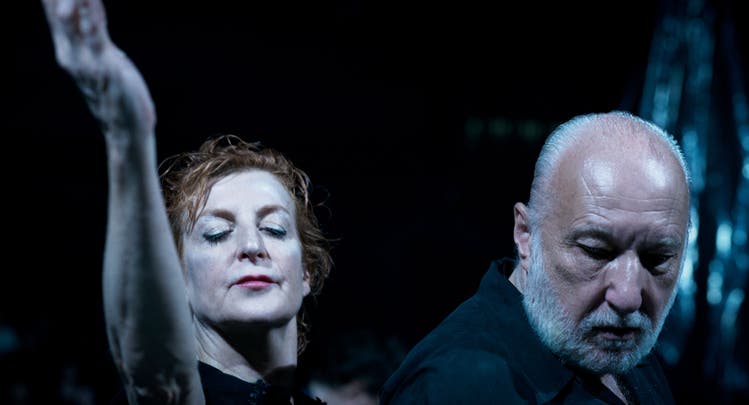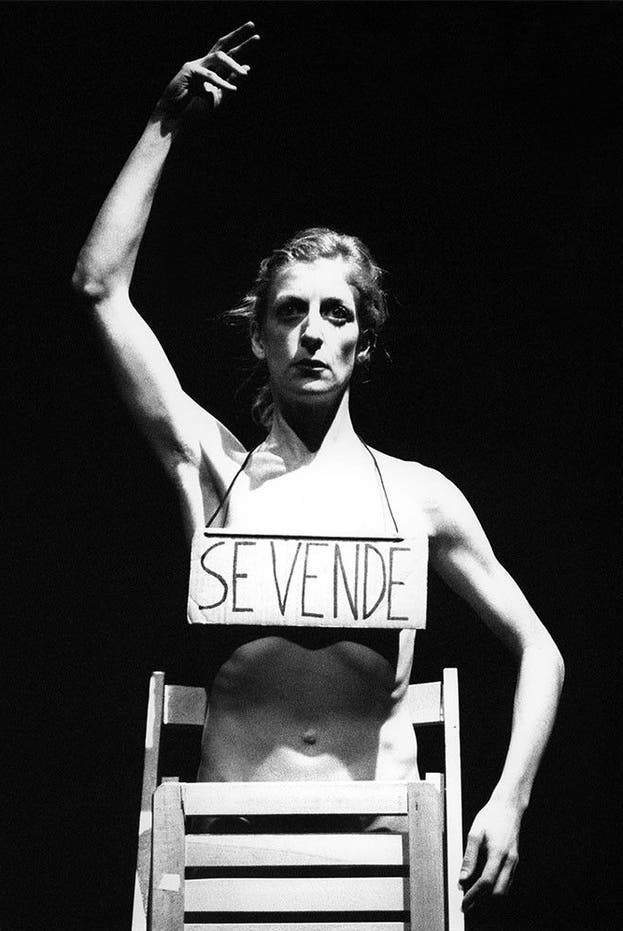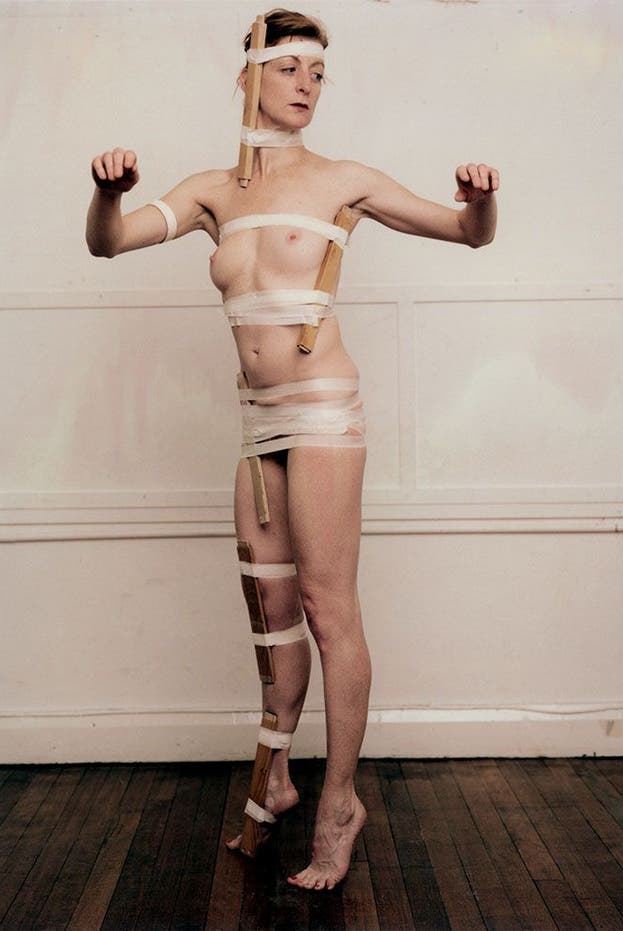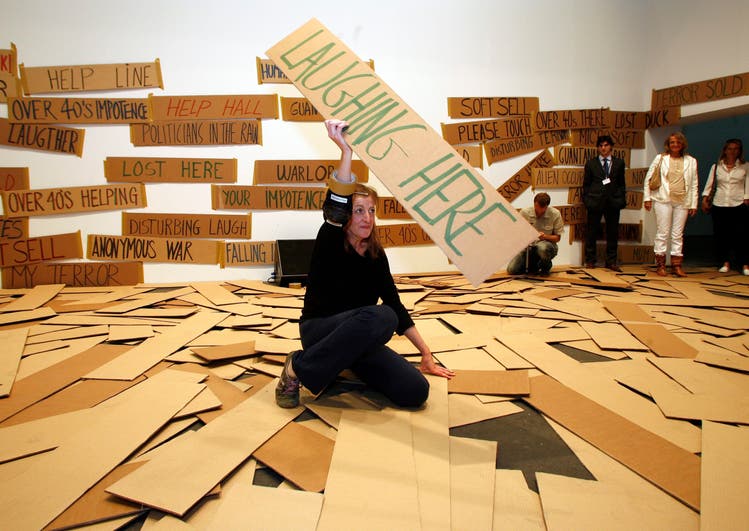In the comedy «Last Dance» the Spanish-Swiss choreographer frightens a man who has to learn to dance.
With an absurd strip in which she shed what felt like hundreds of bizarre layers, La Ribot went from dancer to artist.
When the elderly gentleman enters the theater, he can’t believe his eyes and ears. Those screams, those jumps from the chair – that can’t be dance. And he, Germain, 75, who has never danced in his life, should now slide off his chair too? Should scream what the lungs will bear? To dance? He promised.
He and his wife have agreed that whoever is left will finish what the other started. Now his wife is dead. And he was just in the middle of a dance project by the Geneva-based choreographer La Ribot. So Germain takes her part.
What he sees when he arrives at the theater is an expanded version of «Oh! Sole!», a grotesque farce between blaring arias, death rattles and crochet work that La Ribot created in 1995. Now she frightens Germain with it. It is his “Last Dance” in Delphine Lehericey’s film.
As soon as she read the script, La Ribot says she immediately chose the play with the bright red costumes. “It’s a fantastic piece, very visual, funny.” Exactly, the right thing for the moment when Germain is beginning to fear contemporary dance. “Yes, people are afraid of contemporary dance,” she says casually.
Often imitated, never equalled
Her contemporary dance inspires particular respect: La Ribot is something like the Pina Bausch of the Swiss performance scene, she too has developed her very own form of theatre. Her «Piezas distinguidas», the shortest pieces between dance and fine arts, which she has been thinking about since the early 1990s, have been style-defining for performance art, often imitated but never equalled.
La Ribot made conceptual dance art before the trend from France reached Switzerland. She also began experimenting with video early on. Now she appears with her ensemble in “Last Dance” and plays herself: as the radical artist she has remained. With a keen sensitivity to people and a keen eye for humor in human drama. La Ribot sees things that others don’t see, writes Germain in a letter to his dead wife in the film.

But that looks quite harmonious: La Ribot and her student Germain (François Berléand).
María José Ribot grew up in Madrid. She began training in classical and contemporary dance there before enrolling at the renowned Rosella Hightower ballet school in Cannes. From the mid-1980s she created pieces and toured successfully with her own company. But then she started again. Alone. From 1991 she called herself La Ribot and turned herself into art with the absurd strip «Socorro! Gloria! », in which she shed what felt like hundreds of bizarre layers.
Naked or with second-hand clothes
Her first series is the «13 Piezas distinguidas» – which can be ambiguously translated as «recognizable, outstanding, different, famous pieces». There are solos, between thirty seconds and seven minutes long, in which La Ribot appears naked, with clothes from the second-hand shop, but also with everyday objects and with music. And above all with extended moments of silence.
The solos undermine images of women in art and literature and question the specific place of women in society. The first is «Muriéndose la sirene». La Ribot lies naked on the ground with a blond wig and dies the long death of a mermaid. It is the beginning of a life’s work that will one day be completed with a hundred “Piezas distinguidas”.
The series «Más distinguidas» (1997) and «Still Distinguished» (2000) followed. At that time, the choreographer sold her pieces as ephemeral works of art to “distinguished owners” and thus brought her art closer to the visual arts. While the first solos were created for the stage, the third series took place in exhibition spaces and the audience could move around the artist.

Her solos question the place of women in society. The picture shows La Ribot in the series “Más distinguidas” (1997).

In the series “Still Distinguished” (2000), which took place in exhibition rooms, the public was allowed to move around the artist for the first time.
Since then, however, La Ribot has brought her “Distinguished Pieces” back to the theater, passed them on to a dancer, populated them with dancers or numerous amateurs. In October 2022, the La Ribot Ensemble brought the seventh series “DIestinguished” to the stage in La Chaux-de-Fonds – and thus the 58th “Distinguished Piece”.
Guantánamo performance
La Ribot has grouped her small pieces, combined them, but also created other pieces – like «Laughing Hole», a six-hour performance installation inspired by the Iraq war and the tortures in Guantánamo. And like many particularly innovative artists, she had to wait for recognition. But in 2019 La Ribot was honored with the Swiss Grand Prix Tanz for her life’s work and in 2020 with the Leone d’oro alla carriera at the Venice Dance Biennale.

At Art Unlimited Basel in 2006, La Ribot presented the performance “Laughing Hole”, which was inspired by the Iraq war and the torture in Guantanamo.
La Ribot’s works are meticulous, impossibly precise in the way the body is deployed and the space utilised. This also shows one of the most important distinguishing features compared to many performance works that can be seen in the Swiss dance scene today. Is it because of La Ribot’s classical training? You don’t necessarily need ballet training to become a fantastic dancer,” she says. “I know some without. But it did a lot for me personally.”
It’s not dance what the group is doing, says Germain in “Last Dance”. Whereupon the assistant Samir explains that dance can be many things. “What I do is dance,” says La Ribot herself about her art. The discussion was the fight of her life, for thirty years. «Contemporary dance is contemporary art and open to all sides. But the way the body is used in my work makes it an art of dance.»
Dance as mourning
web · Germain would prefer to read Proust in peace. But when his wife dies unexpectedly, his children and the neighbor buzz around him like helicopter parents. Because he has also promised to finish one of his wife’s projects, he applies for her part in a dance piece by La Ribot. The family must not find out about this, because they would certainly find it unhealthy. As a grieving widower, François Berléand leads a double life in this funny and touching comedy by Delphine Lehericey, which is also a statement against the infantilization of the elderly and for dance as a means of mourning and an opportunity.
“Last Dance” is in the cinema.
